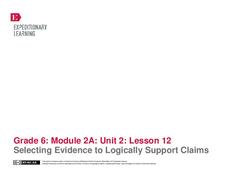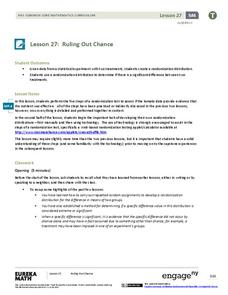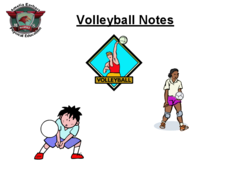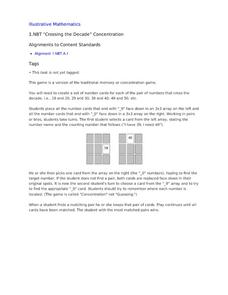Achievement Strategies
CCSS Unit Design Template for PE
From baseball and tennis to capture the flag and four-square, here is a great document that will help you design your next unit on a sport-related activity.
Houghton Mifflin Harcourt
Multiplication Properties and Division Rules
Practice multiplication and division with a worksheet about multiplication properties. After reviewing the commutative property, identity property, zero property, and associative property, kids solve ten multiplication and division...
Visa
Road Rules: Researching and Buying a Car
How do the loan principal, interest rate, and term all factor into a monthly car payment? Introduce your class to some of the key steps and considerations of obtaining a loan and purchasing a car.
Social Skills Central
Listening During a Conversation
What does active listening look like? Learners identify basic rules for listening carefully to others, such as maintaining eye contact and commenting appropriately, and then evaluate different examples of conversations on a worksheet to...
College of Marin
General Addition and Multiplication Rules of Conditional Probabilities
Making connections between multiple methods of solving problems is an important part of understanding conditional probability. The lesson shows solutions to problems using Venn diagrams, tree diagrams, formulas, and two-way tables....
EngageNY
Selecting Evidence to Logically Support Claims
It's time to make a rule sandwich! After exploring the writing assignment's rubric and analyzing a model essay, learners are guided through the prewriting phase using the sandwich technique. Pupils create their sandwich addressing the...
Virginia Department of Education
Laboratory Safety and Skills
Avoiding lab safety rules will not give you super powers. The lesson opens with a demonstration of not following safety rules. Then, young chemists practice their lab safety while finding the mass of each item in a mixture and trying to...
EngageNY
Ruling Out Chance (part 1)
What are the chances? Teach your classes to answer this question using mathematics. The first part of a three-day lesson on determining significance differences in experimental data prompts learners to analyze the data by determining the...
EngageNY
Ruling Out Chance (part 2)
Help your classes find the significance in this lesson! Learners analyze the probability of Diff values. They then determine if the difference is significant based on their probability of occurrence.
EngageNY
Ruling Out Chance (part 3)
Pupils analyze group data to identify significant differences. They use simulation to create their own random assignment data for comparison.
Nemours KidsHealth
Getting Along: Grades K-2
Boost social awareness with two activities focusing on getting along. In the first activity, scholars brainstorm ways to get along with their classmates and create four rules for the classroom. The second activity asks pupils to track...
Curated OER
Number, Number Sense and Operations: Worksheet Four
Review a variety of mathematical skills with this worksheet. In this number sense and operations worksheet, learners solve 15 different problems that include simplifying various equations. In addition, they write the powers in order from...
Math Flix
MathFLIX Challenge: Multiplying and Dividing Fractions
First, math majors compare the multiplication and division of unit fractions and whole numbers. They look for patterns, and then apply their knowledge to an array of multiplication and division problems, all involving fractions and mixed...
Nemours KidsHealth
Fitness: Grades 3-5
Little athletes put their minds and bodies to work to invent new fitness games for class! Using information they gather from informational texts, youngsters design games that include motor skills, materials, rules, and strategies for...
Scholastic
Number Soup
Learners identify the right number "ingredients" to add to their pot of "soup" given a rule that you provide. Whether you are covering even and odd numbers or equivalent expressions, the number soup can be an easy way for learners to...
Curated OER
Atomic Structure and Ionic Bonding (A Visual Approach)
Using toothpicks, marshmallows, and round colored sticky dots, physical science enthusiasts build models of an atomic nucleus. In this eighth grade chemistry lesson plan, they play an atom-naming game with the models that they have...
Curated OER
Hands are for Helping (Responsible Personal Conduct)
Youngster learn the importance of cooperation and sharing through a fun art project! Following a brief introductory discussion in which the class brainstorms how they can use their hands to share, youngster get divided into pairs to...
Curated OER
Rule It Out
Here's a way to create math fact flash cards! Learners create their own cards and sort them into matching categories. Students start with addition and work their way up to harder math such as multiplication, and are asked to notice...
Curated OER
Spelling
After viewing this slide show, which goes over the mosts common reasons for misspellings, students take a short quiz. They must choose the correct version of the underlined word in each sentence, or choose option D; which means "no...
Curated OER
Rules of Thumb for Diction
What is the difference between accept and except? Affect and effect? Brilliantly advise your class with the advice in these slides. Definitions of commonly misused words from A-Z help clarify meaning and usage.
Curated OER
Long Vowel Sounds
Build reading skills, phonemic awareness, or spelling strategies with this super handy presentation. Each slide contains several variations of a long vowel sound and multiple examples of each. This is a great tool to have around,...
Curated OER
Volleyball Notes
Pass, set, spike! That's right, volleyball. Teach the basics of volleyball using this presentation. Review court, positions, serving cues, passing cues, and setting cues. Teach the terminology of a volleyball game using this PowerPoint...
Freecloud Design
Mathmateer
Three, two, one...liftoff! Elevate math skills to new heights while having a blast. A great resource that combines entertainment and education for children of all ages.
Illustrative Mathematics
“Crossing the Decade” Concentration
Young mathematicians concentrate on learning to fluently count. Following the rules of the classic game Memory, children take turns flipping over cards in order to find pairs of numbers that cross a decade (e.g. 29 and 30). For younger...
Other popular searches
- Spelling Rules
- Divisibility Rules
- Classroom Rules
- Spelling Rules Silent E
- Phonics Rules
- Divisibility
- Safety Rules
- Capitalization Rules
- Science Lab Safety Rules
- Decoding Rules
- Phonic Rules
- Class Rules

























